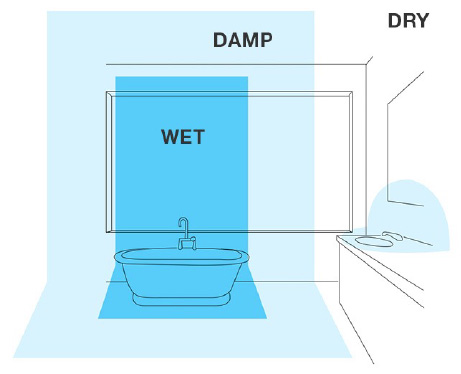Blog
Environmental Ratings: IP vs UL Wet Rating. What is the difference?
When it comes to selecting an LED fixture, it is important to know the level of protection and the environment where the LED fixture is going to be installed. Currently, there are two popular environmental ratings that are being used in the market. They are IP (Ingress Protection) ratings and UL environmental ratings.
What is IP rating? The IEC (International Electrotechnical Commission) has developed the Ingress Protection (IP) ratings, which grade the degree of protection or sealing effectiveness in electrical enclosures against intrusion of objects such as dust and water. The acronym IP is very commonly used for Ingress Protection. And can be seen in the IP protection charts below, different degrees of protection are given ratings.

How is Ingress Protection quoted?
An “IP” number, as it is commonly known, IP ratings are used to specify the environment protection against the luminaires. The IP ratings are comprised of two numbers. The first refers to protection against solid objects (dust) and the second against liquid objects (water).
What does IP55 mean?
It means the equipment is protected against dust – limited ingress but not harmful (IP5x) and resists low pressure jets of water (IPx5).
Is IP68 waterproof?
It means the equipment is protected against dust – No ingress of dust for 2 – 8hrs (IP6x) and resists immersion under water (IPx8). In this case, yes, it is a waterproof fixture.
What is UL environmental rating?
Underwriters Laboratories (UL) marking guides & standards are very popular for product safety & performance rating in many industries. If an LED fixture or lamp has a UL mark and control number, it means it has met all the safety requirements for approved uses and situations. UL is an international organization dedicated to the safety certification of different businesses and services including consumer and workplace products.

UL Dry – Damp – Wet Location:
When it comes to lighting, there are several available options to install depending on the applications and purposes. The UL product listing will help us to avoid any potential risk by dividing the installation locations into three major areas, UL Dry, UL Damp, and UL Wet location.
UL 1598 Standard for Safety – Luminaires defines three moisture protection types of luminaires.
a. UL Dry Locations rating: The luminaires may be installed in location not normally or rarely subject to dampness, but may include a location subject to temporary dampness such as building construction or above the bathroom mirrors, as long as there is enough ventilation to prefent an accumulation of moisture. This means they are typically used indoors in above-ground rooms with addequate ventilation.
b. UL Damp Locations rating: The luminaires may be installed in areas that are regularly exposed to moisture and condensation. These fixtures can safely handle limited amount of moisture, as long as, they are not in direct contact with water or liquid. They can be installed indoor or outdoor locations that are protected, such as covered patios on porches.
c. UL Wet Locations rating: The luminaires may be installed any where that are in direct contact with water or liquid. It could be a slow drip, a strong flow or anything in between. This means they are typically installed in outdoor applications such as outdoor lighting, wall packs, walk way lights, etc. Additionally, UL wet-rated LED fixtures must be installed with a ground wire that connects to a ground fault circuit interrupter (GFCI) to protect against electrical shock hazards.
IP ratings vs UL environmental ratings
IP ratings were designed to be quite specific and unique to more accurately categorize products to help consumers to find specific products with unique category of protection against the intrusion of objects such as water and dust.
UL environmental ratings were designed to help the installers to quickly tell where and how an LED fixture is intended to be installed. In lighting safety installation, environmental ratings related to UL certification (dry/damp/wet), are assigned to products to give a more general idea of where and how the product can be installed. This may not be as detailed as IP ratings, but it serves as an effective general guideline for safe installations.
